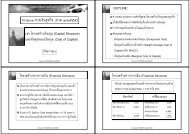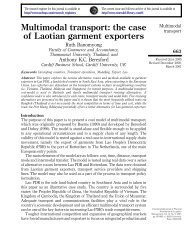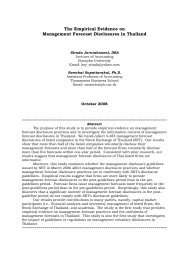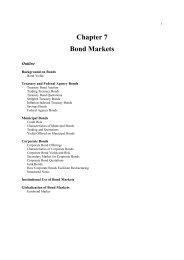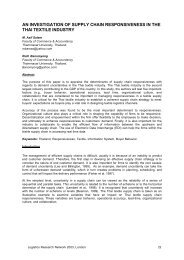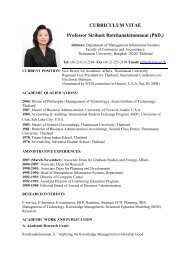The Role of Communication Strategies in Change Management ...
The Role of Communication Strategies in Change Management ...
The Role of Communication Strategies in Change Management ...
You also want an ePaper? Increase the reach of your titles
YUMPU automatically turns print PDFs into web optimized ePapers that Google loves.
Somboon Kulvisaechana<br />
work<strong>in</strong>g here for 17 years. In my perspective, I th<strong>in</strong>k the majority <strong>of</strong> the Consignia<br />
employees understand that we cannot sit back and relax any more because we cannot<br />
afford to lose our bus<strong>in</strong>ess to the competitors.”<br />
- Service Assistant A<br />
<strong>The</strong> issue <strong>of</strong> the term<strong>in</strong>ology, ‘resistance,’ which seems to <strong>in</strong>tr<strong>in</strong>sically convey an undesirable<br />
connotation to the message receivers, is raised dur<strong>in</strong>g the course <strong>of</strong> <strong>in</strong>terviews. Though a<br />
term<strong>in</strong>ological generality <strong>of</strong> “resistance” is denoted and widely used, some employees, who<br />
may or may not be mentally resistant to change, feel fairly defensive aga<strong>in</strong>st it. A certa<strong>in</strong><br />
number <strong>of</strong> <strong>in</strong>terviewees suggest to choose a more appropriate word, which at least carries<br />
literally less defensive connotation, when used to communicate with staff. It could be the<br />
word ‘response’ or ‘reaction.’ In fact, chang<strong>in</strong>g the word itself may not provide a strik<strong>in</strong>g<br />
solution to the resistance to change problem, rather than alleviat<strong>in</strong>g the potential<br />
psychological effect.<br />
“We need to take a close look at what it means by “resistance” and f<strong>in</strong>d the way to<br />
cope with it. Actually, the real problem <strong>of</strong> change resistance is <strong>in</strong>sufficient effort,<br />
time and imag<strong>in</strong>ation given to gett<strong>in</strong>g employees to change. Understand<strong>in</strong>g the<br />
change can br<strong>in</strong>g down a negative response to change, eventually.”<br />
- Board Executive A<br />
Another <strong>in</strong>terest<strong>in</strong>g view toward the term<strong>in</strong>ology <strong>of</strong> ‘resistance to change’ is shown below.<br />
“<strong>The</strong> word ‘resistance’ may make people feel defensive. However, I don’t th<strong>in</strong>k we<br />
should change the word, but we need to change the way we give the message. <strong>The</strong><br />
message should be about creat<strong>in</strong>g the need for people to move forward and<br />
<strong>in</strong>fluenc<strong>in</strong>g them to acknowledge the significance <strong>of</strong> change.”<br />
- Senior Manager B<br />
4.2.5 <strong>Communication</strong> <strong>Strategies</strong><br />
A communication strategy is the key fundamental part <strong>of</strong> the change management strategy.<br />
It facilitates the change process by allow<strong>in</strong>g change messages to cascade down from the top<br />
<strong>of</strong> organization to the operational level. Also, a series <strong>of</strong> effective channel communications is<br />
40





